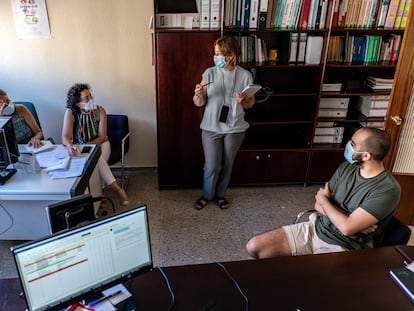Spain records 1,153 daily coronavirus cases, the highest figure since May 1
According to the latest data from the Spanish Health Ministry, the number of new infections is back to where it was when Spaniards were confined to their homes
The Spanish Health Ministry reported on Wednesday that 1,153 coronavirus cases had been detected in the previous 24 hours. This is the highest figure since May 1, when Spaniards were confined to their homes and daily walks and exercise were still not allowed.
The new infections reported on Wednesday were concentrated in three regions: Aragón (424), Catalonia (211) and Madrid (199). But the incidence of the coronavirus in the past seven days has increased in almost all of Spain’s 17 regions: Navarre, with 73 cases per 100,000 inhabitants, has the highest rate, followed by Catalonia (66.1 cases per 100,000), Basque Country (38.5) and Madrid (21.3).
Madrid has seen a particularly large spike in infections, especially among young people, reports Isabel Valdés. Contagion among people between 10 and 19 years of age increased sevenfold in the last 15 days, rising from 16 to 117.
Coronavirus tests are now done on 95% of people with symptoms, compared to less than 50% at the beginning of May
In Murcia, the incidence of Covid-19 in the last seven days is more than 20 cases per 100,000 inhabitants, while in Valencia and La Rioja the figure is over 10. The incidence is lowest in Spain’s exclave cities in North Africa, Melilla (0) and Ceuta (1.1), followed by the Canary Islands (2.4) and Asturias (3.1).
“We are clearly in a second wave, what we have to see now is whether it is bigger or smaller [than the first],” says Rafael M. Ortí Lucas, the president of the Spanish Association of Preventive Medicine, Public Health and Hygiene (Sempsph).
But it is difficult to compare the current figures with the data that was reported during the lockdown period. Before May 25, the Spanish Health Ministry informed about all coronavirus cases reported by regional authorities the day before, regardless of when they had actually been diagnosed. Now, only infections diagnosed in the last 24 hours are announced. If the ministry had used the previous methodology, it would have reported 2,031 daily cases on Wednesday.
Spain’s diagnostic capacity has also greatly improved since the days of confinement. At the beginning of May, tests were being done on less than half of those with coronavirus symptoms, and between 5% and 10% were coming back positive. Now, according to the latest figures from the Health Ministry, tests are carried out on 95% of people with symptoms and the positivity rate is only 1.2%. “This is a sign that transmission has fallen,” said Fernando Simón, the director of the Health Ministry’s Coordination Center for Health Alerts, on Monday.

The average age of coronavirus patients has also dropped, falling from around 60 during lockdown, to 40 for men and 43 for women. According to experts, this is due to several factors, such as seniors being more protected now, and the fact that more asymptomatic cases are being detected thanks to contact tracing. Very few asymptomatic infections were recorded before, but now they represent more than half of all cases. Three months ago, the situation was very different. Most tested people had serious cases of Covid-19, which is more common among senior patients.
The fall in the average age of coronavirus cases has meant that there have been fewer hospital and intensive care (ICU) admissions. On May 1, Spain recorded 732 hospitalizations, 84 ICU admissions and 281 deaths. On July 29, there were 427 hospital admissions, 21 people in ICU and nine deaths recorded in the past seven days – the Health Ministry no longer provides daily data on these figures. This equates to a daily average of 61, three and a little more than one, respectively.
However, it is important to handle these figures with care. Although there has been no spike in coronavirus deaths, the number of hospital admissions has been steadily rising since mid-June, when it reached a record low of fewer than 100 in a week (an average of 14 a day).
The fall in the average age of coronavirus cases has meant that there have been fewer hospital and intensive care admissions
The pressure on hospitals is far from what it was during the peak months of the coronavirus crisis, but in specific regions like Aragón, contingency plans are being prepared in case there is a surge of hospitalizations.
Several regions have introduced other measures aimed at containing the spread of the virus. In Catalonia, for instance, regional authorities called on residents in affected areas to remain at home and avoid all non-essential travel, while in Aragón, four comarcas – an administrative area in parts of Spain – were moved back to Phase 2 of the central government’s deescalation plan.
The president of Sempsph, Ortí Lucas, believes it is too soon to tell whether these measures have worked, given the lapse between infection and the onset of symptoms. “The data is always behind, we will have to wait 10 to 14 days,” he says.
Fernando Rodríguez Artalejo, a professor of epidemiology at Madrid’s Autonomous University, says that strict confinement measures have been proven to curb contagion, but agrees that it is less clear whether the current, more relaxed restrictions will have any effect.
The latest figures from the Health Ministry puts the total number of hospitalizations at 126,690 and the death toll at 28,441. But experts agree that the number of victims is much higher, given that many people died without being tested for Covid-19, meaning they were left out of the official count. Based on the excess death reports from the Carlos III health institute, data from the National Statistics Institute (INE) and figures from regional health authorities, EL PAÍS has calculated that the death toll is likely to be closer to 45,000.
English version by Melissa Kitson.
Tu suscripción se está usando en otro dispositivo
¿Quieres añadir otro usuario a tu suscripción?
Si continúas leyendo en este dispositivo, no se podrá leer en el otro.
FlechaTu suscripción se está usando en otro dispositivo y solo puedes acceder a EL PAÍS desde un dispositivo a la vez.
Si quieres compartir tu cuenta, cambia tu suscripción a la modalidad Premium, así podrás añadir otro usuario. Cada uno accederá con su propia cuenta de email, lo que os permitirá personalizar vuestra experiencia en EL PAÍS.
¿Tienes una suscripción de empresa? Accede aquí para contratar más cuentas.
En el caso de no saber quién está usando tu cuenta, te recomendamos cambiar tu contraseña aquí.
Si decides continuar compartiendo tu cuenta, este mensaje se mostrará en tu dispositivo y en el de la otra persona que está usando tu cuenta de forma indefinida, afectando a tu experiencia de lectura. Puedes consultar aquí los términos y condiciones de la suscripción digital.
More information
Últimas noticias
Most viewed
- Reinhard Genzel, Nobel laureate in physics: ‘One-minute videos will never give you the truth’
- Oona Chaplin: ‘I told James Cameron that I was living in a treehouse and starting a permaculture project with a friend’
- Pablo Escobar’s hippos: A serious environmental problem, 40 years on
- Charles Dubouloz, mountaineering star, retires at 36 with a farewell tour inspired by Walter Bonatti
- Why we lost the habit of sleeping in two segments and how that changed our sense of time











































